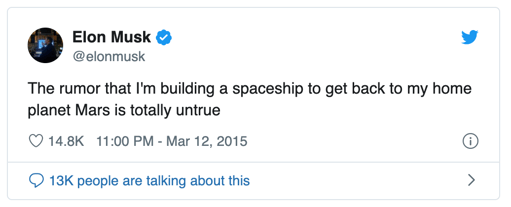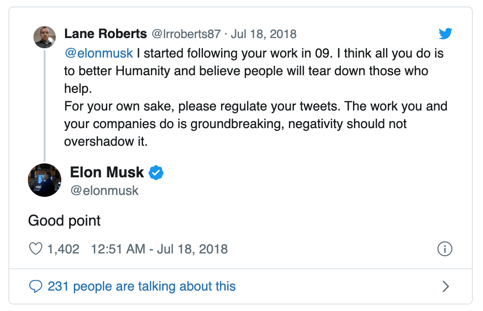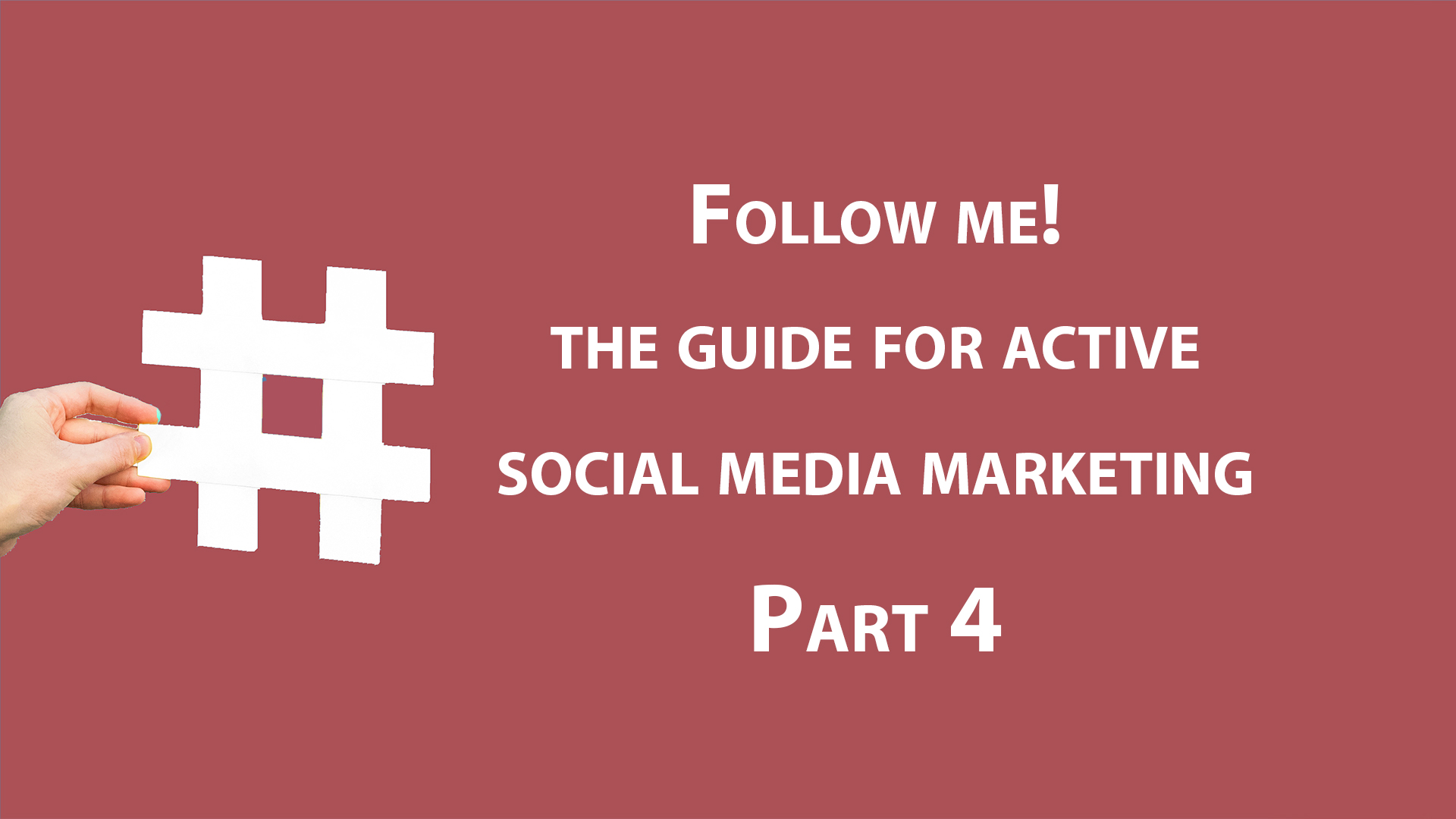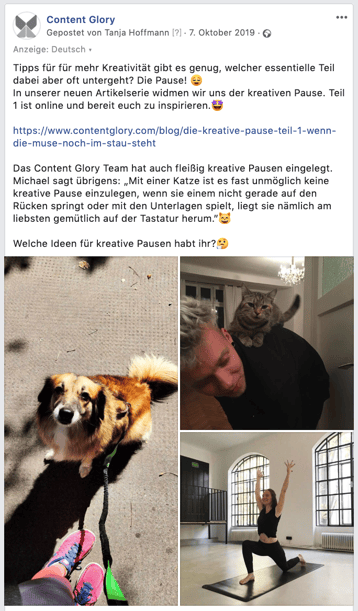You already know how to define your business goals on social media and how to put them into a suitable strategy to reach your goal. From meticulously planning your activities using the content calendar to evaluating the results, everything should be clear at this point. Now that the basic framework is in place, let's turn our attention to the story. And not just any story, but your Core Story, which should be reflected in each of your posts.
The Content Strategy
Setting up your own Facebook or Instagram account is quickly done. Every child can post content – but do they lead to the desired engagements? Your strategy is part of every single post. But for content to be appealing to your target group, it must also be of high quality and designed with the target group in mind. Authenticity is always in the foreground. To avoid just sharing some square photos or pointless links, you need one thing above all: good stories. Your "Core Story ", which runs like a thread through all activities, can help you tell your narrative.
A matter of the heart: your Core Story
The Core Story, the proverbial "heart" of your company, gets to the core of what you stand for: it answers the "who", "why", "how" and „what“ of your projects. But please don't start with "We as a company...believe that..., that's why we want to provide you with the best service every day" – because this is not just about talking about yourself and your mission. Phrase the Core Story from the perspective of your target group.
Experience has shown that it is easier to get to Core Stories via topic areas. One example:
Your company produces pharmaceutical products for a specific disease X. Your Core Story is not primarily about why you are doing it in the first place. Rather, you need to think about what else might interest your target group (in this case, affected persons and their families). A little tip: Imagine your topics as the different sections in a magazine. The Core Story is their common denominator. One example:
- Subject area 1: General information about the disease X
Content Piece: Causes, symptoms and course of disease X. Interview with our expert - Subject area 2: Emotions of those affected
Content Piece: Is disease X hereditary? Our expert Dr. Musterfrau sheds light upon this issue - Subject area 3: Dealing with the symptoms
Content Piece: How Max Mustermann, 39 years old, copes with disease X - Subject area 4: Information for relatives of affected persons
Content Piece: How Mrs. Schmidt and her husband coordinate the healthcare of her parents with disease X - Subject area 5: Current developments in science & research
Content Piece: Researchers from Arizona have discovered new results in research on disease X - Subject area 6: Your product
Content Piece: How you can treat the course of disease of X with medication
A Core Story can already be generated from only these six topic areas:
"Diagnosis X is shocking at first. Those affected are looking for reasons for their illness. They need reliable information to help them alleviate the symptoms. It's all about addressing fears and worries clearly and overcoming them. The involvement of relatives also plays an important role. Together we can help you and your family to cope with the course of the disease. In a way that you can soon live a full life again."
The perfect social media cocktail: Your Content Mix
Don't panic: You don't have to write articles on every single topic all the time. Choose a focus or several topics from which you can create stringent content formats. Focal points can also be set differently for each social media channel:
- LinkedIn: Focus on products and links to current research results
- Facebook: Links to your expert interviews and professional articles
- Instagram: Stories, videos and photos with affected people and their relatives
Do not tell a cock-and-bull story: Good storytelling
Many talk about storytelling, but few know how to do it properly. So let's get back to basics: Storytelling is not a new phenomenon invented by marketers. It is well known that morals and emotions can be conveyed quickly, easily and above all, memorably through fairy tales, i.e. stories. After all, strong emotions stimulate empathy – and the mind. This is where our aim is: Vivid images that the target group remembers and that arouse their interest. But what do we need for this? A recipe:
- Protagonist: A key player, with whom the target group can identify
- Interesting starting point: A situation that is crazy, funny or dramatic and arouses curiosity
- Tension: The protagonist is confronted with conflicts and obstacles that need to be overcome
- Highlight: Stories with happy endings tend to be more suitable for marketing purposes
An example: Industrial enterprise Meyer
Our fictitious company Meyer is planning a webinar to introduce a new product to your target group that requires a lot of explanation: It is a complex machine that can speed up the production process up to 70 %. Of course, the company wants the audience to remain attentive to the topic from start to finish, so that in the end they will buy the product. Meyer therefore opted for the storytelling method when planning the content of the webinar. The structure is organised as follows:
- Once upon a time...
Who is the hero of our story? Where and when does he live?
→ The hero of the webinar is Martin Müller, Head of Production at Heinzel, a company based in Austria. - Every day...
We describe the everyday life and scenery of our hero.
→ Martin Müller goes to work every morning and supervises the production of engine blocks, which his employees assemble partly by hand and partly automatically. - But, one day...
The previous situation of our hero changes, an event or incident disturbs his routine. We describe the conflict in detail.
→ Martin Müller learns from a colleague in Germany that every comparable company has fully automated its production processes, in order to reduce the workload of its employees and produce more cheaply. He notices that his previous approach only adds to the costs and that he is slowly but surely being overtaken by the competition. - After that...
The hero deals with the dilemma and tries first attempts at a solution.
→ "What should I do?", Martin Müller thinks to himself. He researches different approaches used by the competition. But it would be far too expensive to buy completely new machines! He tries to make his employees work more efficiently to save time. - And then...
The hero changes his mentality during the solution attempts, even failure changes him. We describe in detail which changes take place.
→ This and other solution attempts fail. His employees are overworked and simply cannot produce more than they are currently doing. Martin Müller has to think of something else. The advantage: Now he knows what works and what doesn't. His willingness to invest has increased. - Until finally...
The hero can solve the problem, or, with a little support, finds the solution and is redeemed.
→ During his research he came across the blog articles of our company Meyer. He reads their articles and finds out with which modifications he can achieve his goal. An employee of Meyer comes to Müller's company and advises him. Together they find a solution that is financially feasible and implement it. Mr. Müller is relieved of his worries: His company can now once again keep up with the competition and has become even more efficiently.
Facebook content that catches your audience
Now that you can choose a variety of topics and formats from your Core Story, we should consider how you communicate them through social media. On Facebook, one genre in particular is extremely popular.
Funny infotainment
Contributions that are informative, personal, authentic and fun have the greatest potential to be shared. Facebook pages that focus solely on comedy content have exorbitant interaction rates, and for good reason. However, this does not mean that you should use this content as a template for your own content – but it is always good for inspiration! As a company you have to walk the fine line between entertainment and information. Because neither highly stylized brand videos nor slapstick will sell your product. To entertain your target group, Facebook offers videos, livestreams, surveys, 360° photos and videos as well as press-and-hold formats.
For example, we have used the potential of personal posts to launch our series "The Creative Hiatus":
Find the right frequency
But it is not only the content that matters, the frequency of the activities is also of great relevance. For most companies it has become established to post three times a week. However, this guideline is no longer entirely up-to-date in regard to the declining organic reach, as users hardly ever get to see the posts. However, it is a fact that this frequency makes it easier for you to choose your sponsored posts: you simply advertise the post that was most popular last week. Easy. If posts are published separately over a long time, the scheme does not work as well. If in doubt, you can follow this rule: One highlight post every two weeks, which you push with advertising budget. The frequency you decide on depends on the amount of your content.
Follow the laws of the news feed
- Videos
On Facebook, you can only reach your target group in the long term if you post videos. The problem of many companies: 85 % of users stop Facebook videos after only three seconds. However, brand awareness is still increasing. Nevertheless, we are not satisfied with this. You have three seconds to make a lasting impression. The best way to do this is with striking visual elements and additional text, such as headlines or keywords. Stories or interviews should last at least three minutes, otherwise Facebook will classify your content as irrelevant. Exceptions are statements or impressions from everyday work, which may be shorter from time to time.
- Vertical format
Social and mobile must never be separated, because most content is consumed on the go. When creating your content, always ask yourself if it will work in the mobile version. So choose formats such as 4:5 or 1:1 – whether for photos or videos.
- Pro tip: Subtitles
80 % of the videos are consumed without sound. Subtitles are therefore an absolute must for every video. Upload your video to YouTube, for example, where you can automatically or manually add subtitles and download the finished video for further distribution on Facebook and Co.
How-to Instagram
While three posts per week are enough for Facebook, Instagram users demand high-quality content every day. One or two posts per day is optimal, if possible you should also upload one story per day.
- Stories
Storytelling and stories are the dream team at Instagram. Simply fan out your sequences as a storyboard and post them step by step. Add stickers, fonts, geotags and tag people to generate additional reach.
- Pictures
Pay attention to a good quality of the photos and to an aesthetic placement of the motives (keyword: golden ratio!). The raster function can support you here: Your main motif should be placed on one of the intersections to look attractive. You can add the finishing touches to your photos using filters (e.g. from apps like VSCO or Snapseed). Make sure you choose a consistent style throughout your feed.
A little tip for penny-pinchers: There are numerous image and video databases that provide free files, such as Adobe Spark, Canva, and Pexels.
- Picture caption
Use the caption to describe your photos. A little tip: If you use hashtags, separate them from the caption with a few paragraphs, this looks tidier and doesn't distract from the essential content. It's best to use five to ten appropriate hashtags and don't clutter up your caption. You should not do without it, because hashtags are real kick starters for your post. You can use them to bring posts to the hashtag search page, where other users will become aware of your site.
- Videos
Depending on your product, you can film and post exercises, instructions, how-to videos or DIYs. Or use the format to make an exciting announcement!
Chirp into the conversation with 280 characters
Twitter is a great tool to run your own agenda setting for your brand. However, you may not exceed 280 characters per post. Little space that you need to use wisely. If you succeed in producing and sharing interesting content, you will be rewarded with loyal users.
Making Twitter the boss's business
Many company bosses are holding back on Twitter. But where does this shyness come from? This is probably due to the existing uncertainties and unanswered questions in dealing with social media. But a presence on relevant channels such as Twitter is as important as your own business card. Entrepreneurs like Elon Musk show how it's done: Communication with followers at eye level that makes you smile. This makes his account one of the most popular on Twitter, as entertainment, current information about the company and news are skillfully combined. A few examples (little warning: this level of self-dramatization and exaggeration is not suitable for everyone):



What should I tweet?
Personal opinions or rather serious reports about the company? Neither one nor the other. On Twitter, the winner is the mix of interesting content that is not limited to one tonality. The channel is a place where it is all about the exchange from person to person. So don't treat it as an extended PR department! With calculated, clinical tweets you will not establish a connection to your followers. Instead, let your followers participate in the discourse. A few suggestions:
- Tell them about your daily life as an executive
- Report on current events in the company
- Answer the tweets of your followers
- Retweet interesting or entertaining tweets from other users
- Post links to exciting articles
- Announce blog posts or news first of all on Twitter
- Take a survey
- Put your employees in the spotlight, for example, ask the trainee to report on her experiences
With all this chirping, you should of course always make sure that all information is in line with your corporate identity to communicate a consistent corporate image. Training the employees responsible for this is a good start.
Stay tuned...
The right choice of words, length and the right tonality – writing posts for social media can be a real challenge for companies. In the next part of the series, we'll take you by the hand so that you always hit the right tone.
Sources:
https://kresse-discher.de/blog/ist-die-core-story-im-content-marketing-ein-missverstaendnis/
https://www.youtube.com/watch?v=z4WvHJ3X7j4
Grabs, Anne/Bannour, Karim-Patrick/Vogl, Elisabeth: Follow me! Erfolgreiches Social Media Marketing mit Facebook, Instagram, Pinterest und Co. Bonn: Rheinwerk Verlag. 2019.
Credit: ©khosrork/Adobe Stock



